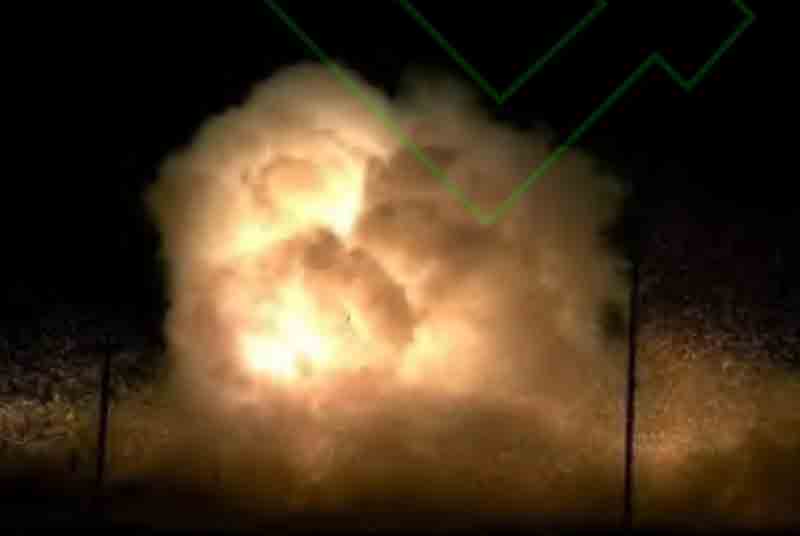In a controlled field experiment carried out by Chinese scientists, a two-kilogram explosive device produced a fireball that exceeded 1,000 degrees Celsius and lasted for more than two seconds—15 times longer than a similar explosion from TNT.
This device, developed by the 705 Research Institute of the China State Shipbuilding Corporation (CSSC), a prominent entity in underwater weaponry, is characterized as a non-nuclear hydrogen bomb. It utilizes a magnesium-based solid-state hydrogen storage material known as magnesium hydride.
The findings of this test, published in a peer-reviewed article in the Chinese-language Journal of Projectiles, Rockets, Missiles, and Guidance, represent a significant advancement in China’s military technology, raising concerns about its potential uses and the wider implications for global security.
Although the device does not utilize nuclear materials, its capacity to inflict prolonged thermal damage positions it as an innovative asset in contemporary warfare, leading analysts to evaluate its significance in China’s strategic objectives.
The explosive device functions through a distinct mechanism that differentiates it from conventional chemical or nuclear weapons. Magnesium hydride, a silvery powder, can store hydrogen at a density much higher than that of traditional pressurized tanks, a characteristic that was initially investigated for clean energy solutions such as fuel cells in remote areas.
When activated by a conventional explosive, the magnesium hydride breaks down into micron-sized particles, triggering a rapid thermal decomposition that releases hydrogen gas. This gas then combines with the surrounding air and ignites, resulting in a white-hot fireball capable of melting aluminum alloys.
The test demonstrated a maximum overpressure of 428.43 kilopascals at a distance of two meters, which is approximately 40% of the explosive force of TNT. However, its thermal impact significantly exceeded that of traditional explosives, presenting a novel method for achieving precise destruction across extensive areas.
This technological advancement relies on China’s capacity to address considerable production hurdles related to magnesium hydride. Traditionally, the material’s high reactivity posed challenges for production, with laboratories only able to generate a few grams daily under strict conditions due to the risk of spontaneous combustion when exposed to air.
Recently, a new facility in Shaanxi province, which began operations earlier this year, has successfully increased production to 150 tonnes per year by employing a “one-pot synthesis” technique developed by the Dalian Institute of Chemical Physics. This safer and more economical method has not only facilitated the development of this explosive device but has also paved the way for additional military uses, such as powering fuel cells for submarines and long-endurance drones.
The facility’s production marks a significant transition from limited laboratory experiments to large-scale industrial output, highlighting China’s advancing capabilities in sophisticated materials and its dedication to incorporating clean energy solutions into its military framework.
The creation of this device should be viewed in the context of China’s extensive military modernization initiatives. In recent years, the People’s Liberation Army (PLA) has emphasized technological innovation to bolster its global presence, especially in contested areas like the South China Sea.
The China State Shipbuilding Corporation (CSSC), renowned for its progress in naval and underwater technologies, is central to this strategy. Its 705 Research Institute has a rich history of developing advanced weaponry, including torpedoes and unmanned underwater vehicles (UUVs).
The magnesium hydride device’s lightweight design, coupled with its significant thermal capabilities, indicates its potential for integration into various platforms. For example, a torpedo utilizing this technology could inflict severe heat-based damage on enemy ships or infrastructure, while an unmanned underwater vehicle (UUV) could use it for coastal defense or area denial missions.
Additionally, the device’s compact form factor makes it ideal for targeted strikes against widely dispersed targets, such as supply hubs or troop formations, providing tactical versatility in asymmetric warfare.
To understand the importance of this advancement, it is helpful to compare it with current non-nuclear explosives employed by other nations. The United States, for instance, has utilized thermobaric weapons like the BLU-118/B, which create extreme heat and pressure to obliterate fortified positions and personnel in enclosed areas.
Similarly, Russia’s TOS-1A “Buratino” rocket launcher employs thermobaric munitions with devastating results, especially in urban warfare. While these weapons depend on fuel-air mixtures for extended explosions, the Chinese device’s magnesium hydride offers a more compact and potentially more manageable option.
In contrast to thermobaric weapons that necessitate larger delivery systems, the two-kilogram Chinese device can be launched from smaller platforms, including drones or precision-guided munitions.
Its thermal output can maintain temperatures exceeding 1,000 degrees Celsius for several seconds, surpassing the brief 0.12-second explosion of TNT. This characteristic makes it particularly effective for targets that require prolonged heat exposure, such as fuel depots and communication hubs.
The historical quest for non-nuclear weapons with strategic significance has influenced military strategies globally. During the Cold War, both the United States and the Soviet Union investigated fuel-air explosives and enhanced blast weapons to effectively counter armored units and fortifications without escalating to nuclear conflict.
These initiatives were motivated by the necessity to uphold deterrence while complying with international agreements aimed at limiting nuclear proliferation. China’s recent development aligns with this tradition, providing a weapon that offers considerable destructive capability within the constraints of current arms control agreements.
In contrast to nuclear weapons, which China tested from 1964 until it signed the Comprehensive Nuclear-Test-Ban Treaty in 1996, the magnesium hydride device does not pose a risk of radioactive fallout, making it a legally and politically acceptable option for deployment in various situations. This is consistent with China’s official no-first-use nuclear policy, which prioritizes conventional and technological superiority to achieve strategic goals.
The timing of this test is significant, especially in light of rising geopolitical tensions in the Indo-Pacific region. While some analyses have connected China’s military developments to potential conflicts over Taiwan, the versatility of the magnesium hydride device indicates a wider range of possible applications.
For instance, in a maritime setting, it could be employed to disrupt naval supply routes or incapacitate essential infrastructure along disputed coastlines. Its capability to “easily achieve uniform destruction of targets across extensive areas,” as noted by Wang Xuefeng’s team, further highlights its potential in area denial strategies, aimed at preventing adversaries from accessing critical terrain or resources.
This capability would hold significant importance in the South China Sea, where China has strengthened its artificial islands and increased its naval presence to assert its territorial claims. By incorporating such a weapon into its military arsenal, China could improve its power projection capabilities without crossing into nuclear territory.
In addition to its direct military uses, the advancement of this technology signifies China’s strategic commitment to dual-use innovations. The potential of magnesium hydride as a clean energy source for submarines and drones underscores the PLA’s focus on sustainable military solutions.
In March, China revealed a 7.2 percent rise in its defense budget, totaling $249 billion, with an emphasis on integrating renewable energy sources such as solar, wind, and hydrogen into its military operations. This move aligns with global trends, as countries like the United States investigate hydrogen fuel cells for next-generation naval vessels and unmanned systems.
For example, the U.S. Navy’s XLUUV (Extra Large Unmanned Underwater Vehicle) initiative aims to create long-endurance submarines powered by alternative energy sources, mirroring China’s interest in magnesium hydride for similar applications. The ability to produce this material on a large scale provides China with a competitive advantage, not only in weaponry but also in the wider race for energy innovation.
However, despite its notable capabilities, the magnesium hydride device has its drawbacks. Its blast pressure, which is only 40% that of TNT, makes it less effective against heavily armored targets or bunkers, where kinetic force is essential.
The dependence on thermal damage raises concerns regarding its efficacy in challenging conditions, such as strong winds or rain, which may disperse the hydrogen gas prior to ignition. Additionally, although the Shaanxi facility has made strides in overcoming production hurdles, the long-term scalability and safety of magnesium hydride remain in question.
Previous incidents, including a 2019 explosion at a hydrogen startup in France, highlight the dangers associated with handling such reactive substances. The Chinese research paper notably lacks information about the origin of the magnesium hydride utilized in the experiment, hinting at potential sensitivities related to its production or supply chain. These omissions necessitate caution when evaluating the device’s immediate operational readiness.
The global reaction to this advancement will likely center on its ramifications for arms control and regional stability. In contrast to nuclear weapons, which are governed by treaties like the Non-Proliferation Treaty, non-nuclear explosives encounter fewer regulatory limitations.
Nevertheless, the destructive capacity of the magnesium hydride device could ignite discussions about the necessity for new regulations to oversee advanced conventional weapons. For the United States, this test serves as a stark reminder of China’s advancing technological capabilities and its intent to challenge Western supremacy in military innovation.
The Pentagon’s 2024 report on China’s military capabilities indicated that the People’s Liberation Army is increasing its nuclear stockpile to over 600 warheads, yet the emergence of non-nuclear alternatives like this device suggests a complementary strategy to enhance its military capabilities.
In reaction, the U.S. may expedite its own investigations into high-energy explosives or countermeasures, including sophisticated thermal protection for vehicles and infrastructure.
Looking forward, the magnesium hydride device has the potential to alter both tactical and strategic considerations in contemporary warfare. Its compact design and extended thermal effects render it a flexible asset for offensive and defensive maneuvers, especially in maritime and asymmetric engagements.
However, its introduction also highlights the difficulties of sustaining technological dominance in a time of swift innovation. For China, this test exemplifies its capability to convert scientific advancements into military uses, bolstering its goal to excel in essential technologies.
For the United States and its allies, this raises a critical question: how can they counter a weapon that merges the accuracy of traditional explosives with the destructive heat of a chemical blaze? As the global arms race progresses, the solutions to this dilemma will influence the future of conflict and deterrence in an increasingly intricate world.
Discover more from Defence Talks | Defense News Hub, Military Updates, Security Insights
Subscribe to get the latest posts sent to your email.





